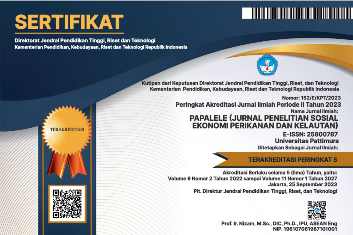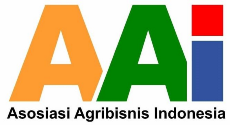WISATA BAHARI PADA ZONA PEMANFAATAN TAMAN NASIONAL MANUSELA: POTENSI DAN FAKTOR PENGARUH PENGEMBANGAN
Abstract
Tourism has become one of the major players in ‎international commerce and represents one of the main income ‎sources for many developing countries at the same time. These dynamics have turned tourism into a key driver for socio-‎economic progress.‎ This article described the potential of tourism attraction and factor affecting the development of marine tourism area in the utilization zone of Manusela National Park. Semi-structured interviews, in-depth interviews and participant observations were conducted with respondent (n=110) in Bellarizky, Air Belanda, Ora Beach and Lizar Bahari resort. The potential of tourist attractions in the utilization zone of Manusela National Park is as a snorkeling, diving and point of view. Factors affecting the development are service, transportation, supporting facilities and tourism attractions.
Downloads
References
Abdi, H., dan Williams, L.J. 2010. Principal Component Analysis. Wires Comp Stat, 2 : 433-459.
Cerny, B.A., dan Kaiser, H.F. 1977. A Study of A Measure of Sampling Adequacy for Factor-Analytic Correlation Matrices. Multivariate Behavioral Research, 12 (1) : 43-47.
Chen, H., dan Rahman, I. 2018. Cultural Tourism: An Analysis of Engagement, Cultural Contact, Memorable Tourism Experience and Destination Loyalty. Tourism Management Perspectives, 26 : 153-163.
Coll M, Piroddi C, Steenbeek J, Kaschner K, Lasram F.B.R, Aguzzi J, Vafidis D, Villanueva R, Voultsiadou E. 2010. The biodiversity of the Mediterranean Sea: forecasts, patterns,and threats. J PLoS One. 2. 5 (8) : e11842
Denscombe, M. 2007. The Good Research Guide for Small-scale Social Research Projects (3rd ed.). Berkshire, England: Open University Press
Field, A. 2009. Discovering statistics using SPSS. Thousand Oaks (CA): Sage Publications, India.
Frochot, I. 2005. A Benefit Segmentation of Tourists In Rural Areas: A Scottish Perspective. Tourism Management, 26 (3), 335-346.
Higgins-Desbiolles, F. 2018. Sustainable Tourism: Sustaining Tourism or Something More?. Tourism Management Perspectives, 25 : 157-160.
Indah, D., dan Susetyo, C. 2017. Analisis Faktor-Faktor yang Mempengaruhi Pengembangan Kawasan Pariwisata Bahari di Gili Labak, Kabupaten Sumenep. Jurnal Teknik ITS, 6 (1) : 75-77.
IUCN (International Union for Conservation of Nature). 2017. National Park. https://www.iucn.org/theme/protected-areas/about/protected-areas-categories/category-ii-national-park akses 12/06/2018
Joshi, A., Kale, S., Chandel, S., dan Pal, D.K. 2015. Likert Scale: Explored and Explained. British Journal of Applied Science and Technology, 7 (4) : 396-403.
Kaiser, H.F. 1974. An Index of Factorial Simplicity. Psychometrika, 39 : 31-36.
Kastenholz, E dan Lima, J. 2011. The Integral Rural Tourism Experience From The Tourist’s Point Of View – A Qualitative Analysis of Its Nature and Meaning. Tourism and Management Studies, 7 : 62-74.
Kementerian Kehutanan., Ditjen Perlindungan Hutan dan Konservasi Alam., dan Balai Taman Nasional Manusela. 2014. Buku Informasi Wisata Alam Balai Taman Nasional Manusela. Kementerian Kehutanan, Ditjen Perlindungan Hutan dan Konservasi Alam, dan Balai Taman Nasional Manusela, Masohi – Maluku.
Kvale, S., and Brinkmann, S. 2009. Den Kvalitativa Foskningsintervjun. Lund: Studentliteratur, Swedia.
Lane, B. 2009. Rural Tourism: An Overview, in Jamal, T., & Robinson, M., (Eds.) The SAGE Handbook of Tourism Studies, Sage Publications, London.
Li, K.X., Jin, M., dan Shi, W. 2018. Tourism as an Important Impetus To Promoting Economic Growth: A Critical Review. Tourism Management Perspectives, 26 : 135-142.
Li, Y., Hu, C., Huang, C., dan Duan, L. 2017. The Concept of Smart Tourism in The Context of Tourism Information Services. Tourism Management, 58 : 293-300.
Marasabessy, I., Fahrudin, A., Imran, Z., dan Agus, SB. 2017. Karakteristik Pulau Kecil: Studi Kasus Nusa Manu dan Nusa Leun untuk Pengembangan Ekowisata Bahari di Maluku Tengah. Simposium Nasional Konservasi Perairan Pesisir dan Pulau-Pulau Kecil.
Papageorgiou, M. 2016. Coastal and Marine Tourism: A Challenging Factor in Marine Spatial Planning. Ocean and Coastal Management, 129 : 44-48.
Pletsas, D., Barrento, S., Masters, I., and Atkinson-Willes, J. 2018. Tourism – Building Industries at Sea: ‘Blue Growth’ and the New Maritime Economy. River Publishers, Denmark.
Ribero, M dan Marques, C. .2002. Rural Tourism And The Development Of Less Favoured Areas - Between Rhetoric And Practice, International Journal of Tourism Research, 4 (3), 211-220.
Satryanto, R., dan Pamungkas, A. 2015. Analisa Faktor-Faktor yang Mempengaruhi Pengembangan Kawasan Wisata Bahari Lhok Geulumpang, Aceh Jaya. Jurnal Teknik ITS, 4 (1) : 6-10.
Shirkey, E.C., dan Dziuban, C.D. 1976. A Note on Some Sampling Characteristics of the Measure of Sampling Adequacy (MSA). Multivariate Behavioral Research, 11 (1) : 125-128.
Torres-Delgado, A., dan Palomeque, F.L. 2017. The ISOST Index: A Tool for Studying Sustainable Tourism. Journal of Destination Marketing and Management, 7 : 26-30.
Tribe, J. 2004. The Economics of Recreation, Leisure and Tourism. Elsevier, UK.
Wijaya, N., and Furqan, A. 2017. Coastal Tourism and Climate-Related Disasters in an Archipelago Country of Indonesia: Tourist’ Perspective. Procedia Engineering, 12 : 535-542.
World Tourism Organization (UNWTO). 2017. Why Tourism?. http://www2.unwto.org/content/why-tourism akses 12/06/2018
Yulianda, F. 2007. Ekowisata Bahari Sebagai Alternatif Pemanfaatan Sumberdaya Pesisir Berbasis Konservasi. Standar Sains Departemen Manajemen Sumberdaya Perairan. Fakultas Perikanan dan Ilmu Kelautan-Institut Pertanian Bogor, Bogor.
Copyright (c) 2018 Ivonne R. Kaya, Fildo de Lima

This work is licensed under a Creative Commons Attribution-NonCommercial 4.0 International License.











